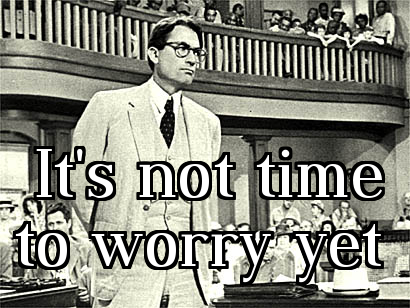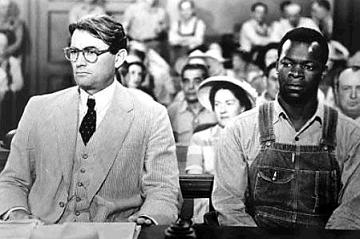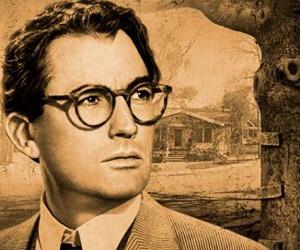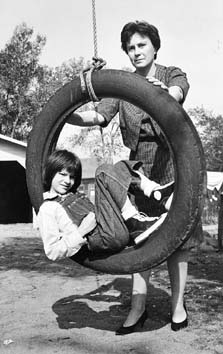To Kill a Mockingbird Themes: Prejudice, Racism, Justice and Courage
To Kill a Mockingbird Themes
Since its publication in 1960, To Kill a Mockingbird by Harper Lee has sold over 30 million copies. Although set in the 1930s in the fictional American town of Maycomb, the central themes and issues of To Kill a Mockingbird are just as relevant to society today. So prevalent are the issues of To Kill a Mockingbird that it has been cited by the American Library of Congress as being second only to the Bible as the book that had made a difference in people's lives.
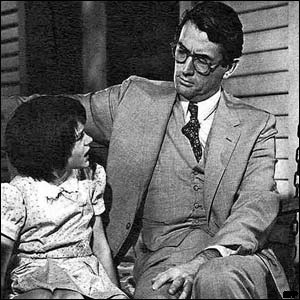
Atticus and Scout in the film adaptation of
To Kill a Mockingbird
Main Characters of To Kill a Mockingbird
To Kill a Mockingbird is narrated from the viewpoint of Scout, a young girl of about six years old who is the daughter of another central character, Atticus Finch. Atticus is the voice of justice and rationalism speaking out in a town full of highly emotional and ignorantly prejudiced people. A lawyer, the courage and integrity of Atticus never wavers throughout To Kill a Mockingbird as we are shown one of the few figures who truly holds justice and moral beliefs above the prejudices of society.
The Mockingbird Theme
The main themes of To Kill a Mockingbird are illustrated through two major subplots running parallel throughout the novel. One of the major themes in the novel is the mockingbird motif. Atticus feels that it is wrong to kill a mockingbird because all they do is sing beautiful songs and never harm anyone. This theme is illustrated through the trial of Tom Robinson.
A black man, Tom Robinson is accused of raping Mayella Ewell, a white woman. In this subplot, the racially prejudiced nature of Maycomb is clearly portrayed through such instances as the fact that Atticus is accused by the town of loving black people for defending Tom's case and also through the lynch mob scene outside the jail. It is in the Tom Robinson trial that the greatest example of injustice because of prejudice is seen. Although Atticus actually manages to prove the innocence of Tom Robinson, the white jury still refuses to declare the innocence of a black man over a white, resulting in the most blatant testimony to the fact that the town of Maycomb held racial discrimination above justice. Through its decision, the town essentially kills a mockingbird. Tom Robinson was a man who did no harm to others but instead actually helped others out of kindness - a mockingbird who becomes victim to a racist society.
The Theme of Another Man's Shoes
The second motif again concerns the nature of prejudice and is illustrated through the subplot of Boo Radley. Atticus tells his children that we never really know a man until we stand in his shoes and walk around in them. This theme is represented through Boo Radley, a man surrounded by mystery and rumors and hence prejudices. It is this prejudice that initially consumes Scout at the beginning of To Kill a Mockingbird as she imagines Boo to be some kind of monster. However, Boo's kindness towards the children ultimately prevails and he even ends up saving their lives towards the end of the novel. In the end Scout even comes to accept Boo as a friend despite her original prejudice. This goes to show that we have no right to judge others since we cannot fully understand their viewpoint.
Conclusion
To Kill a Mockingbird is narrated entirely through the eyes of Scout who is initially a typically prejudiced Maycomb child who is quick to turn to fighting and force as a solution to conflicts. However, through such scenes as the lynch mob outside the jail where Scout disperses the entire mob simply by talking to them rather than by force and also through the Boo Radley subplot we see her mature and progress to become a rational and wiser character. This progression is essentially brought about by Atticus and shows that views and beliefs are ultimately passed on from parents and so through the right upbringing and teaching, children can overcome the prejudices held by society. And if a child such as Scout living in a 1930s society can learn to overcome such deeply held prejudices and come to understand the individual worth of a person then surely people living in today's society can too.
To Kill a Mockingbird Themes
One of the biggest issues we face every day is prejudice. We may judge people on the color of their skin, the type of car they drive, or even the way their hair is done. Whatever the prejudice may be, everyone has got one. In Harper Lee's very successful novel, To Kill a Mockingbird, this fact of life is faced head-on. Every chapter challenges our right to judge others. With a relaxed style, Lee weaves a challenging novel, with many challenging characters.
The Theme of Prejudice
To Kill a Mockingbird does not just show the racial prejudice of the 1930s, but it also shows many other types of prejudice that were common among people in small, slow-moving towns like Maycomb in the USA, which is where the book was set. With a child-like innocence, the author retells the story of her childhood through the eyes of Scout, a six year-old girl without a mother, and a lawyer for a father.
Scout's father, Atticus Finch, is an almost too perfect father. He teaches his children, Jem and Scout, strong and upright morals, and frequently says that "You never really understand a person... until you climb into his skin and walk around in it" (Chapter 3 of To Kill a Mockingbird).
The Theme of Mockingbirds
It is Atticus' fine moral standards that call him to the defense of Tom Robinson, an innocent black man who has been charged with the rape of a white girl. Even after Atticus so clearly proves Tom innocent, the jury comes to the inevitable decision: "guilty... guilty... guilty" (Chapter 21 of To Kill a Mockingbird). Here Harper Lee is showing the tragic fate of a mockingbird in society. After showing nothing but kindness and helpfulness to the community, Tom is judged guilty of rape for one simple reason: he is black and she is white.
The title, To Kill a Mockingbird, refers to the prejudice of Maycomb against the people who have done nothing but good for the community. A mockingbird in society is someone who continuously helps people and does good things, but gets unfairly discriminated against in spite of this. Tom Robinson is the most obvious mockingbird in the novel. Tom ends up suffering for a wrong not committed by him. Boo Radley is also a cleverly created mockingbird who the children discriminate against, even when all along he has been giving them gifts and helping them.
The mockingbirds in our present society are the people who you hear only bad things about from the press, when they are really only trying to do good for you and me. Mockingbirds in the novel are also largely affected by what people make up about them through gossip.
The Theme of Gossip
Gossip among citizens and neighbors is one of the most effective ways of spreading prejudice. When a story is told and retold all around a town, those with wild imaginations are sure to add their own touches to the story, and put more lies into it than there is truth. Children are usually the best at making up stories, as most children have very fertile imaginations, and love to add their own creative ideas. This is represented in the book when one of the characters, Boo Radley, who the children have never seen, is made out to be almost a monster with strange ways and habits and an unstable mind. In the end, the children learn the truth about Boo, and from then on they know he is just very shy, and has been secluded from society by his parents.
By being excluded from society since he was a teenager, Boo was kept separate from most of the prejudice and beliefs of the community of Maycomb, excepting only what he could see from the living room window. Boo never saw any of the racial prejudice that said that a white man's word is better than a black man's.
Children, Education and Dealing with Prejudice
How can these problems be addressed? First of all, changing the way society thinks starts with changing children and the way they think. It is almost impossible to change the way adults think and their moral values and prejudices, so children need to be educated to have an unprejudiced outlook on fellow citizens. We cannot avoid biased opinions, but we can build in children admirable moral standards.
Atticus displays this well as he tries to teach his children not to have common views and share society's prejudices, but to analyze and discover the truth for themselves, without forcing his own views on them. In the book, the children easily learn from watching the adults, to judge other children according to where they lived, what clothes they wore, and what their surname was. Scout is taught by her father not to judge little Walter Cunningham because he is different, but to simply accept him.
We see this kind of discrimination in the adult characters also, when Aunt Alexandra and "the ladies" have their so called, "missionary meetings" to drink fine tea, daintily eat biscuits, and gossip about all the poor, unfortunate citizens of Maycomb. But, as seen in the book, even Scout Finch, a six year-old girl, could not bear to listen to the way they gossiped about others.
Conclusion
The only way to avoid prejudice in society is to shield children from our own, and to teach them to see everyone as equal. This way, they will not see a need to put everyone into categories they think they should be in. Adults cannot change the way they think, but, with a little help, can nurture something special in the hearts of their kids so they may grow up to respect each and every person, for the person he is.



